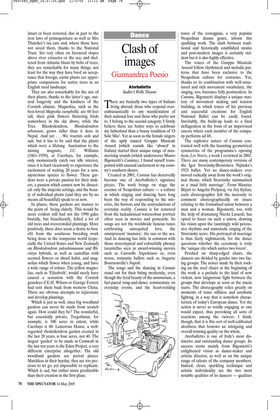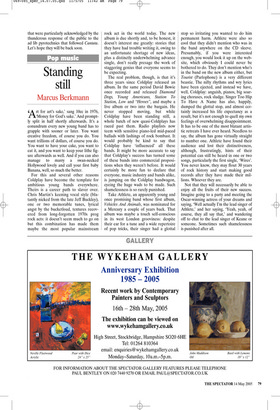Clash of images
Giannandrea Poesio
Aterballetto
Sadler’s Wells Theatre
There are basically two types of Italians living abroad: those who respond over enthusiastically to any manifestation of their national lore and those who prefer not to. I belong to the second category; I firmly believe there are better ways to celebrate my fatherland than a brassy rendition of ‘O Sole Mio’. Yet as soon as the female singers of the aptly named Gruppo Musicale Assurd (which sounds like ‘absurd’ in Italian) started their unique range of mesmerising sounds (which underscores Mauro Bigonzetti’s Cantata), I found myself transported with unusual excitement to my country’s southern shores.
Created in 2001, Cantata has deservedly become one of Aterballetto’s signature pieces. The work brings on stage the essence of Neapolitan culture — a culture in which singing and dancing have long been the way of responding to the miseries, the horrors and the contradictions of everyday reality. Cantata is far removed from the lackadaisical watercolour portrait often seen in movies and postcards. Its songs are not the worldwide famous tunes celebrating unrequited love, the omnipresent ‘mamma’, the sun or the sea. And its dancing has little in common with those stereotypical and colourfully phoney tarantellas seen in award-winning movies such as Carosello Napoletano or, even worse, romantic ballets such as Auguste Bournonville’s Napoli.
The songs and the dancing in Cantata stand out for their biting modernity, even though the feral beauty of the tammuriata, a fast-paced song-and-dance commentary on everyday events, and the heart-rending tones of the sceneggiata, a very popular Neapolitan drama genre, inform this sparkling work. The clash between traditional and historically established modes and post-modern images is certainly strident but it is also highly effective.
The voices of the Gruppo Musicale Assurd follow rhythmical and melodic patterns that have been exclusive to the Neapolitan culture for centuries. Yet, thanks to its combination with well-structured and rich movement vocabulary, the singing, too, becomes fully postmodern. In Cantata, Bigonzetti displays a unique mastery of movement making and tension building, in which traces of his previous and successful creations for English National Ballet can be easily found. Inevitably, the build-up leads to a final deflagration in the form of an improvised encore where each member of the company performs ad lib.
The explosive nature of Cantata contrasted well with the haunting geometrical symmetries of the programme’s opening item, Les Noces, a work I reviewed in 2002. There are many contemporary versions of the Igor Stravinsky/Bronislava Nijinska’s 1923 ballet. Yet no dance-makers ever moved radically away from the work’s original theme, which Stravinsky summarised as a ‘mad little marriage’. From Maurice Béjart to Angelin Preljocaj, via Jiry Kylian, each choreographer felt the necessity to comment choreographically on issues relating to the formalised union between a man and a woman. Bigonzetti, too, with the help of dramaturg Nicola Lusardi, has opted to focus on such a union, drawing his vision upon the tauntingly wild percussive rhythms and unmelodic singing of the Stravinsky score. His portrayal of marriage is thus fairly nightmarish, for the dance questions whether the ceremony is truly the ‘unique rite which unites two lovers’.
Perched on sharp-edged chairs, the dancers are divided by gender into two facing groups. The noises made by their rocking on the steel chairs at the beginning of the work is a prelude to the kind of now violent, now languorous fight between the groups that develops as soon as the music starts. The choreography relies greatly on moments of tense stillness and acrobatic fighting, in a way that is somehow characteristic of today’s European dance. Yet the action is never as totally engaging as one would expect, thus provoking all sorts of reactions among the viewers. I think, though, that it is this sort of well-calibrated aloofness that bestows an intriguing and overall winning quality on the whole.
Aterballetto is one of Italy’s most distinctive and outstanding dance groups. Its success stems mainly from Bigonzetti’s enlightened vision as dance-maker and artistic director, as well as on the unique range of talents of the company members. Indeed, clean, sparkling technique and artistic individuality are the two most notable qualities of its dancers — qualities that were particularly acknowledged by the thunderous response of the public to the ad lib pyrotechnics that followed Cantata. Let’s hope they will be back soon.



































































 Previous page
Previous page